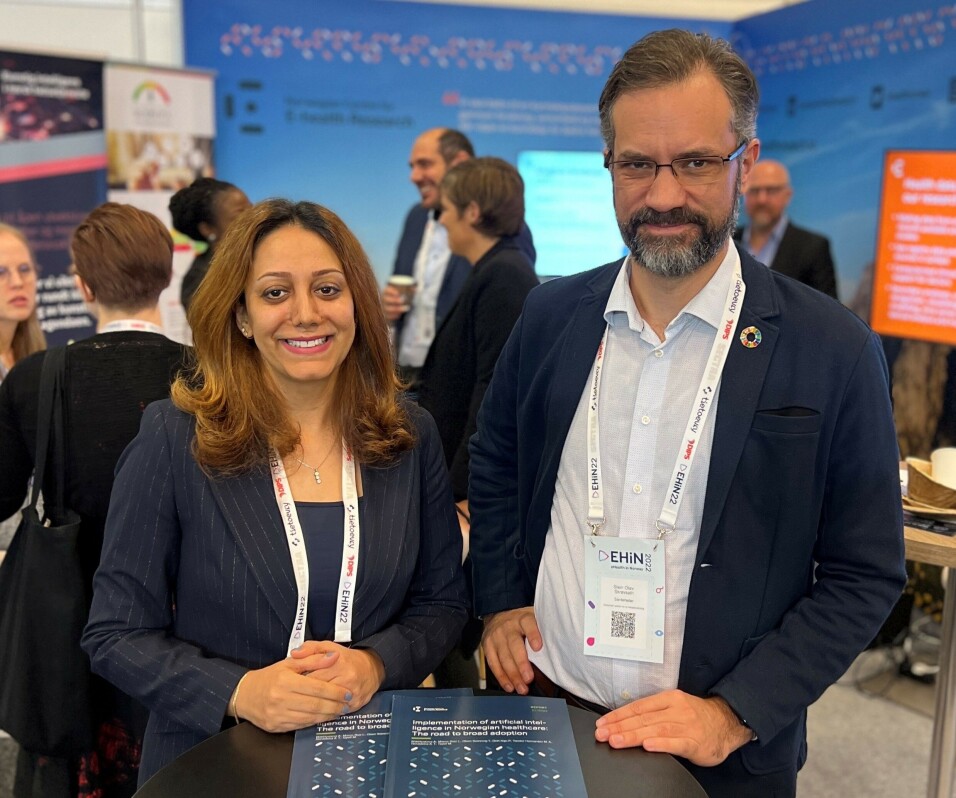THIS ARTICLE/PRESS RELEASE IS PAID FOR AND PRESENTED BY the Norwegian centre for E-health research - read more

Will there be more use of artificial intelligence in the Norwegian healthcare system?
Researchers have investigated what is needed to introduce artificial intelligence in the Norwegian healthcare system. They recommend that there be more of it.
Artificial intelligence, abbreviated AI, can have great potential as something useful for patients, healthcare personnel and the Norwegian society in general.
Researchers at the Norwegian Centre for E-health Research know that only a few of the many existing projects with artificial intelligence are adapted to the healthcare system.
So, what is preventing AI from finding its way from research to the clinic?
This was one of the questions the researchers asked themselves in a comprehensive study on the implementation of artificial intelligence in the health service. The study is now the basis for a report that contains the researchers' recommendations.
"The aim of the report has been to examine these obstacles and identify the actions that must be taken to facilitate the transition of AI from research to clinical practice," project manager and senior researcher Maryam Tayefi at the Norwegian Centre for E-health Research says.

AI can also make mistakes
There is an ongoing debate about the ethical, clinical and financial advantages and disadvantages of using artificial intelligence and algorithms to treat patients.
Artificial intelligence can potentially provide new insights and simplify healthcare institutions' and patients' handling of health information. However, it can also involve a significant risk in terms of privacy, ethics and medical errors.
Balancing the risks and benefits of AI in the health service will require a joint effort from technology developers, decision makers, health institutions and patients.
Sustainable introduction of AI
The report provides a comprehensive description of the phases in the introduction of AI, from planning to implementation. The report also contains proposals and recommendations for the authorities.
The knowledge is based on interviews, summaries of existing research, strategies and reports.
Maryam Tayefi has been working on the report since 2021. She clearly believes that artificial intelligence can improve the efficiency of the health service and the quality of medical treatment.

Recommendations to Norwegian health authorities
The researchers believe that Norway has many preconditions for successful introduction of AI in the health sector. We have several large health data registers with data collected over many decades, a large number of available IT specialists, expertise research groups in the area, and acceptance of new technology in general.
Nevertheless, more actions are needed at national level and in health organisations to achieve widespread use in the healthcare system.
The recommendations for AI adoption to authorities and health organisations are as follows:
- Increase knowledge about AI among healthcare personnel and citizens.
- Focus on clinical needs and patient perspectives in the implementation process.
- Collaboration across disciplines and sectors is important for coordinated initiatives.
- Regulations must be adapted to the new technology.
- Improve opportunities for funding and ensure distribution of medical and computer science resources for AI implementation
- Improve data challenges such as quality, access, storage and exchange.
- Upgrade current ICT infrastructure.
- Standardise implementation and procedures for procurement.
- Ensure clinical approval before implementation of AI systems in the health service. And ensure maintenance for systems being introduced.

Collaboration and a good digital infrastructure
The patients and health personnel must play as a team to get artificial intelligence into place in the Norwegian health service.
The report shows that it is just as important to have close collaboration between different disciplines, technologists and clinicians. And it is essential to have a digital infrastructure that facilitates technological development in the health services.
"The health service is already using artificial intelligence, so it is more a question of what to use it for and how much to use it. Artificial intelligence is not a goal in itself either. It will be used for better and more efficient patient treatment,"Lars Bjørgan Schrøder says.
He is the director general at the Ministry of Health and Care Services.
During the launch of the report, he said that history shows that what you think is going to happen, never turns out quite as expected. Innovations often take longer to implement than expected.
The Norwegian Ministry of Health and Care Services has therefore established Helsedataservice (link in Norwegian) as part of the Directorate for e-health. Helsedataservice will make it much easier and faster for researchers to access health data from several registers.
Reference:
Makhlysheva et al. Implementation of artificial intelligence in Norwegian healthcare: The road to broad adoption, Norwegian Centre for E-health Research, Report number 01-2022.

This article/press release is paid for and presented by the Norwegian centre for E-health research
This content is created by the Norwegian centre for E-health research's communication staff, who use this platform to communicate science and share results from research with the public. The Norwegian centre for E-health researchis one of more than 80 owners of ScienceNorway.no. Read more here.
See more content from the Norwegian centre for E-health research:
-
Technology in the health and care sector: "This is not just about new gadgets"
-
Five Nordic and Baltic countries take a major step toward the future of health research
-
A digital chatbot can help you stay fit
-
Researchers' advice for better healthcare services: Listen to the patient!
-
Half of those who received mental health care found errors in their medical records
-
AI can understand your medical records: A new language model could revolutionise healthcare





































